The Hydrogen Generator Market is estimated to be valued at USD 0.8 billion in 2025 and is projected to reach USD 1.5 billion by 2035, registering a compound annual growth rate (CAGR) of 7.1% over the forecast period. An early versus late growth curve comparison reveals distinct phases in market expansion. Between 2025 and 2030, the market grows from USD 0.8 billion to USD 1.1 billion, contributing USD 0.3 billion in growth, with a CAGR of 8.3%.
This early-phase growth is driven by increasing demand for clean energy solutions and the growing adoption of hydrogen-based technologies in industries such as manufacturing, transportation, and power generation. Governments' push for greener energy alternatives and industrial players’ focus on reducing emissions play a significant role in driving the market during this phase.
The market sees its first peak at USD 1.1 billion in 2030, reflecting strong initial growth. From 2030 to 2035, the market continues to grow from USD 1.1 billion to USD 1.5 billion, adding USD 0.4 billion in growth, with a slower CAGR of 5.9%. This later-phase growth reflects the market maturing, with widespread adoption of hydrogen generators and reduced incremental demand in established markets.
However, emerging markets continue to drive growth, while technological advancements and cost reductions maintain market expansion. The comparison shows early strong acceleration, followed by more stable growth as the market reaches maturity.
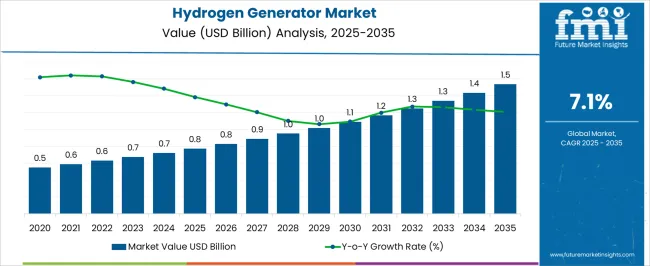
| Metric | Value |
|---|---|
| Hydrogen Generator Market Estimated Value in (2025 E) | USD 0.8 billion |
| Hydrogen Generator Market Forecast Value in (2035 F) | USD 1.5 billion |
| Forecast CAGR (2025 to 2035) | 7.1% |
The hydrogen generator market is witnessing significant expansion driven by the increasing global emphasis on clean energy and sustainable industrial processes. The rising demand for hydrogen as a versatile energy carrier and feedstock is fueling investments in hydrogen generation technologies.
Advances in production methods and growing environmental regulations aimed at reducing carbon emissions are accelerating the adoption of hydrogen generators in various industries. On-site hydrogen generation is gaining traction as it offers operational flexibility, reduces transportation risks, and lowers costs.
Moreover, the chemical processing sector continues to drive market growth due to its significant demand for hydrogen in refining, ammonia production, and other chemical syntheses. Technological innovations and government support for clean hydrogen initiatives are expected to bolster the market further. Segmental growth is anticipated to be led by onsite hydrogen generators, steam reforming as the dominant process, and chemical processing as the primary application.
The hydrogen generator market is segmented by type, process, application, capacity, and geographic regions. By type of the hydrogen generator market is divided into Onsite and Portable. In terms of process, the hydrogen generator market is classified into Steam Reforming, Electrolysis, and Others. Based on application, the hydrogen generator market is segmented into Chemical Processing, Petroleum Recovery, Fuel Cells, Refinery, and Others. By capacity, the hydrogen generator market is segmented into 100-2,000Nm3/h, 100 Nm3/h, and >2,000Nm3/h. Regionally, the hydrogen generator industry is classified into North America, Latin America, Western Europe, Eastern Europe, Balkan & Baltic Countries, Russia & Belarus, Central Asia, East Asia, South Asia & Pacific, and the Middle East & Africa.
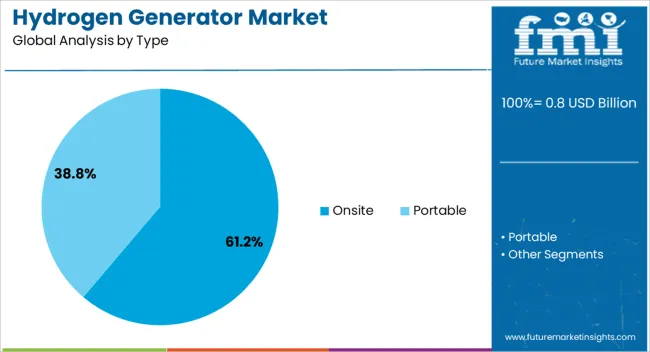
The onsite hydrogen generator segment is projected to hold 61.2% of the market revenue in 2025, securing its position as the leading type. This segment’s growth is attributed to the advantages of producing hydrogen at the point of use, which eliminates the need for storage and transportation logistics.
Industries prefer onsite generation for enhanced safety, cost savings, and uninterrupted supply, particularly in large-scale operations. Onsite systems also enable better integration with existing industrial setups and renewable energy sources.
The increasing focus on decentralized hydrogen production to support various applications is fueling this segment’s expansion. As demand for flexible and scalable hydrogen solutions grows, onsite generators are expected to maintain their market dominance.
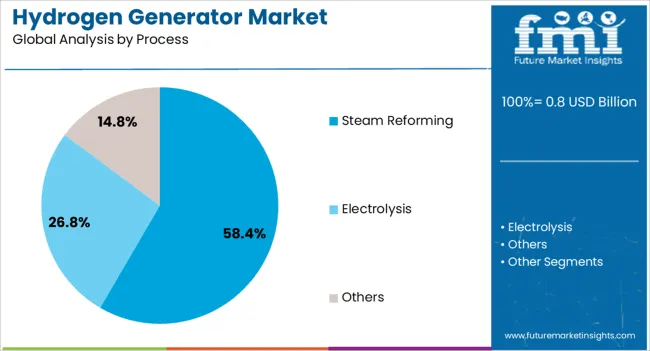
The steam reforming process segment is expected to account for 58.4% of the hydrogen generator market revenue in 2025, leading the process category. Steam reforming remains the most widely used commercial method due to its cost-effectiveness and efficiency in producing large volumes of hydrogen from natural gas or other hydrocarbons.
Industry adoption of steam reforming has been sustained by advancements in catalyst development and process optimization, improving yield and reducing emissions.
Despite the emergence of alternative green hydrogen production methods, steam reforming continues to dominate due to existing infrastructure and economic advantages. With ongoing efforts to integrate carbon capture and storage technologies, steam reforming is positioned to remain a key process in hydrogen generation.
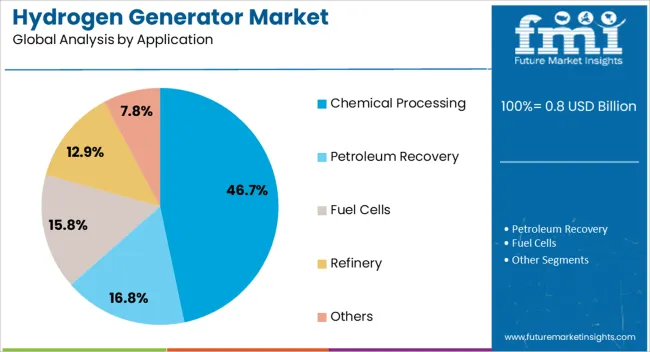
The chemical processing application segment is projected to hold 46.7% of the market revenue in 2025, maintaining its lead as the primary hydrogen consumer. Hydrogen is critical in numerous chemical processes including refining, ammonia synthesis, and methanol production, which drive demand for reliable generation technologies.
Chemical plants increasingly rely on onsite hydrogen generation to ensure a steady supply tailored to their operational needs. Regulatory pressures and sustainability goals are prompting these industries to adopt cleaner hydrogen sources and more efficient generation methods.
The expansion of the chemical sector, particularly in emerging markets, supports sustained growth in this application segment. As hydrogen’s role in chemical processing evolves towards greener alternatives, this segment is expected to continue its significant contribution to the hydrogen generator market.
The hydrogen generator market is expanding due to increasing demand for clean energy solutions across various industries, including chemicals, automotive, and power generation. Hydrogen generators provide on-site production of hydrogen gas, which is used in fuel cells, industrial applications, and energy storage. The growing shift toward renewable energy sources and the rising demand for hydrogen fuel cells in electric vehicles are driving the adoption of hydrogen generators.
Despite challenges like high capital costs and regulatory hurdles, advancements in hydrogen production technologies are fostering market growth and creating new opportunities.
The hydrogen generator market is primarily driven by the growing demand for clean energy solutions and the increasing adoption of hydrogen fuel cells. As governments, industries, and consumers shift towards cleaner energy alternatives to reduce reliance on fossil fuels, hydrogen is becoming a key player in the energy mix. Hydrogen fuel cells, which are used in electric vehicles (EVs), industrial power generation, and backup power systems, are gaining traction due to their efficiency and zero-emission capabilities.
The growing need for on-site hydrogen production in industries such as oil refining, food processing, and electronics further fuels the demand for hydrogen generators. As the hydrogen economy expands, hydrogen generators are becoming an essential component in meeting the global demand for clean, sustainable energy solutions.
A significant challenge in the hydrogen generator market is the high capital cost of hydrogen generation systems. While the technology has advanced, the infrastructure required to produce hydrogen, particularly green hydrogen from renewable sources, is still expensive to install and maintain.
This high upfront cost can be a barrier for many businesses and industries looking to adopt hydrogen generators, especially in emerging markets with limited financial resources. Additionally, regulatory barriers such as complex safety standards, environmental regulations, and lack of clear policy frameworks can hinder the growth of the hydrogen generator market. Navigating these regulatory challenges requires manufacturers and users to invest in compliance measures, increasing the complexity and cost of implementing hydrogen generation systems.
The hydrogen generator market offers significant opportunities driven by advancements in green hydrogen technology and the expansion of hydrogen infrastructure. Green hydrogen, produced using renewable energy sources such as wind or solar power, is gaining attention as a sustainable solution to reduce carbon emissions. Technological innovations in electrolyzer design, which improve efficiency and lower production costs, are making green hydrogen more viable and economically competitive. Furthermore, the increasing investment in hydrogen infrastructure, including fueling stations and production facilities, is opening new markets for hydrogen generators.
The expansion of hydrogen-based applications in industries such as transportation, energy storage, and power generation offers long-term growth opportunities for manufacturers. As the hydrogen economy evolves, hydrogen generators are becoming integral to realizing a low-carbon energy future.
A key trend in the hydrogen generator market is the increasing integration of hydrogen production with renewable energy systems. The combination of hydrogen generation and renewable energy sources, such as solar and wind, is becoming more common as industries seek to produce green hydrogen in a cost-effective and environmentally friendly manner. The growing adoption of digital technologies, such as advanced monitoring and control systems, is also transforming hydrogen generation processes.
These systems allow for real-time data analysis, predictive maintenance, and optimization of energy usage, improving the overall efficiency and reliability of hydrogen production. As industries seek to increase energy resilience and reduce reliance on traditional energy sources, the trend of integrating hydrogen generation with renewable energy systems is expected to continue to grow, making hydrogen a cornerstone of future energy solutions.

The hydrogen generator market is projected to grow at a CAGR of 7.1% from 2025 to 2035. Of the five profiled markets out of 40 covered, China leads at 9.6%, followed by India at 8.9%, and France at 7.5%, while the United Kingdom records 6.7% and the United States posts 6.0%. These rates translate to a growth premium of +35% for China, +25% for India, and +5% for France versus the baseline, while the United States and the United Kingdom show slower growth. Divergence reflects local catalysts: increasing adoption of hydrogen generation technologies in industries such as energy, manufacturing, and transportation in China and India, while more mature markets like the United States and the United Kingdom experience more moderate growth due to established infrastructure and widespread usage. The analysis includes over 40+ countries, with the leading markets detailed below.
Demand for hydrogen generators in China is growing at a 9.6% CAGR through 2035. China’s rapidly expanding industrial and energy sectors are the primary drivers of this growth. The country’s push to reduce carbon emissions and transition toward cleaner energy sources is increasing the demand for hydrogen generation technologies. China’s large-scale industrial and manufacturing sectors, along with the rising demand for hydrogen fuel in transportation and energy production, are accelerating the adoption of hydrogen generators. Additionally, government initiatives and investments aimed at promoting renewable energy sources further support this market growth.
Sale of hydrogen generators in India is projected to grow at an 8.9% CAGR through 2035. India’s focus on transitioning to renewable energy sources and increasing energy efficiency is driving the adoption of hydrogen generation technologies. The country’s expanding industrial base and rising demand for clean energy solutions in sectors such as transportation, agriculture, and manufacturing further contribute to market growth. Government policies aimed at reducing emissions and promoting green energy initiatives are further accelerating the demand for hydrogen generators in India. Additionally, India’s push for hydrogen as a cleaner alternative to conventional fuels supports this trend.

Demand for hydrogen generators in France is growing at a 7.5% CAGR through 2035. France’s commitment to clean energy, coupled with its growing industrial base, is driving the adoption of hydrogen generation technologies. The country’s focus on reducing its carbon footprint and transitioning to renewable energy sources is accelerating the demand for hydrogen generators. France’s strong automotive sector, especially its push toward hydrogen fuel cell vehicles, further supports market growth. Additionally, France’s government policies and incentives aimed at promoting green technologies and reducing fossil fuel dependency contribute to the expanding hydrogen generator market.
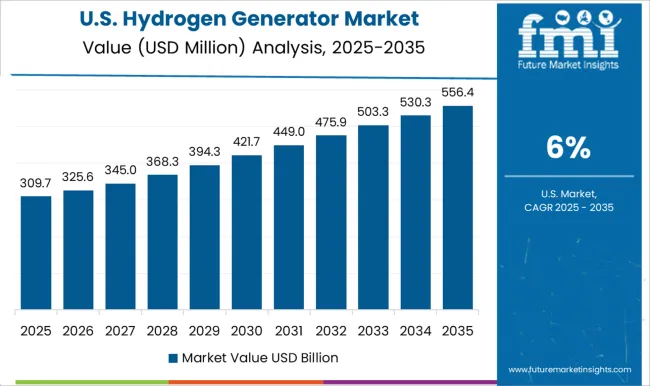
The hydrogen generators market in the USA is projected to grow at a 6.0% CAGR through 2035. The USA market for hydrogen generation is driven by the growing need for clean and efficient energy sources, particularly in industries like transportation, manufacturing, and power generation. The rise in investments in hydrogen fuel cell technologies and energy storage solutions is accelerating the demand for hydrogen generators. Additionally, the USA government’s increasing support for renewable energy solutions and its push for clean energy adoption in various sectors are further driving the market growth.
Sale of hydrogen generators in the UK is projected to grow at a 6.7% CAGR through 2035. The UK’s growing focus on renewable energy and decarbonization, especially in industrial applications, is a major driver of the hydrogen generator market. The country’s strong commitment to achieving net-zero emissions by 2050, combined with increasing investments in hydrogen infrastructure and energy storage solutions, accelerates market adoption. The UK’s rising focus on hydrogen as a clean fuel alternative in transportation, particularly in heavy industries and public transportation, is another contributing factor to the growth of this market.
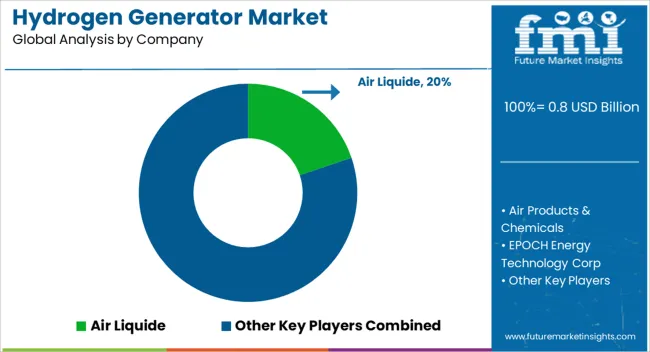
The hydrogen generator market is led by established industrial gas and energy technology companies such as Air Liquide, Linde, Air Products and Chemicals, Nel ASA, and ITM Power, which dominate through extensive portfolios of on-site and modular hydrogen generation systems for industrial, transportation, and energy applications. These companies differentiate themselves through efficiency, reliability, and the ability to integrate electrolysis and steam methane reforming technologies at various scales. Historical strategies focused on industrial supply contracts, large-scale energy projects, and strategic partnerships with automotive and chemical manufacturers to secure long-term demand. Regional expansion has been pursued through localized production facilities, joint ventures, and government-backed green hydrogen projects, with Europe, North America, and the Asia-Pacific being key growth regions due to energy transition policies.
Emerging players, including Plug Power, McPhy Energy, and HyGear, are entering with innovative electrolysis solutions, modular designs, and renewable energy integration to serve niche markets and support the hydrogen economy. Market challenges include high capital costs, fluctuating energy input prices, the need for technology standardization, and the requirement for regulatory compliance across various regions. Forecast strategies indicate a push toward scaling up green hydrogen production, integrating storage and distribution networks, and forming strategic alliances with the energy and mobility sectors to capture the increasing demand from decarbonization initiatives globally.
| Item | Value |
|---|---|
| Quantitative Units | USD 0.8 Billion |
| Type | Onsite and Portable |
| Process | Steam Reforming, Electrolysis, and Others |
| Application | Chemical Processing, Petroleum Recovery, Fuel Cells, Refinery, and Others |
| Capacity | 100-2,000Nm3/h, 100 Nm3/h, and >2,000Nm3/h |
| Regions Covered | North America, Europe, Asia-Pacific, Latin America, Middle East & Africa |
| Country Covered | United States, Canada, Germany, France, United Kingdom, China, Japan, India, Brazil, South Africa |
| Key Companies Profiled | Air Liquide, Air Products & Chemicals, EPOCH Energy Technology Corp, Idroenergy, Linde plc, McPhy Energy, Nel ASA, Praxair Technology, ProtonOnsite, and Teledyne Technologies Incorporated |
| Additional Attributes | Dollar sales by product type (electrolyzers, steam methane reformers, other hydrogen production systems) and end-use segments (industrial hydrogen production, clean energy, transportation, chemical manufacturing, energy storage). Demand dynamics are influenced by the growing push towards clean energy, the rising use of hydrogen in fuel cells, and the increasing adoption of hydrogen in heavy industries. Regional trends show strong growth in Europe and North America, driven by government incentives for clean energy solutions, while Asia-Pacific is expanding rapidly due to increasing industrialization and the push for hydrogen as a fuel source in emerging economies. |
The global hydrogen generator market is estimated to be valued at USD 0.8 billion in 2025.
The market size for the hydrogen generator market is projected to reach USD 1.5 billion by 2035.
The hydrogen generator market is expected to grow at a 7.1% CAGR between 2025 and 2035.
The key product types in hydrogen generator market are onsite and portable.
In terms of process, steam reforming segment to command 58.4% share in the hydrogen generator market in 2025.






Our Research Products

The "Full Research Suite" delivers actionable market intel, deep dives on markets or technologies, so clients act faster, cut risk, and unlock growth.

The Leaderboard benchmarks and ranks top vendors, classifying them as Established Leaders, Leading Challengers, or Disruptors & Challengers.

Locates where complements amplify value and substitutes erode it, forecasting net impact by horizon

We deliver granular, decision-grade intel: market sizing, 5-year forecasts, pricing, adoption, usage, revenue, and operational KPIs—plus competitor tracking, regulation, and value chains—across 60 countries broadly.

Spot the shifts before they hit your P&L. We track inflection points, adoption curves, pricing moves, and ecosystem plays to show where demand is heading, why it is changing, and what to do next across high-growth markets and disruptive tech

Real-time reads of user behavior. We track shifting priorities, perceptions of today’s and next-gen services, and provider experience, then pace how fast tech moves from trial to adoption, blending buyer, consumer, and channel inputs with social signals (#WhySwitch, #UX).

Partner with our analyst team to build a custom report designed around your business priorities. From analysing market trends to assessing competitors or crafting bespoke datasets, we tailor insights to your needs.
Supplier Intelligence
Discovery & Profiling
Capacity & Footprint
Performance & Risk
Compliance & Governance
Commercial Readiness
Who Supplies Whom
Scorecards & Shortlists
Playbooks & Docs
Category Intelligence
Definition & Scope
Demand & Use Cases
Cost Drivers
Market Structure
Supply Chain Map
Trade & Policy
Operating Norms
Deliverables
Buyer Intelligence
Account Basics
Spend & Scope
Procurement Model
Vendor Requirements
Terms & Policies
Entry Strategy
Pain Points & Triggers
Outputs
Pricing Analysis
Benchmarks
Trends
Should-Cost
Indexation
Landed Cost
Commercial Terms
Deliverables
Brand Analysis
Positioning & Value Prop
Share & Presence
Customer Evidence
Go-to-Market
Digital & Reputation
Compliance & Trust
KPIs & Gaps
Outputs
Full Research Suite comprises of:
Market outlook & trends analysis
Interviews & case studies
Strategic recommendations
Vendor profiles & capabilities analysis
5-year forecasts
8 regions and 60+ country-level data splits
Market segment data splits
12 months of continuous data updates
DELIVERED AS:
PDF EXCEL ONLINE
Hydrogenerators Market
Onsite Hydrogen Generator Market Size and Share Forecast Outlook 2025 to 2035
Portable Hydrogen Generator Market Size and Share Forecast Outlook 2025 to 2035
Portable Hydrogen Powered Generator Market Size and Share Forecast Outlook 2025 to 2035
Generator Bushing Market Size and Share Forecast Outlook 2025 to 2035
Hydrogen Storage Tank And Transportation Market Forecast Outlook 2025 to 2035
Hydrogen Detection Market Forecast Outlook 2025 to 2035
Hydrogenated Dimer Acid Market Size and Share Forecast Outlook 2025 to 2035
Hydrogen Electrolyzer Market Size and Share Forecast Outlook 2025 to 2035
Hydrogen Fluoride Gas Detection Market Size and Share Forecast Outlook 2025 to 2035
Hydrogen Storage Tanks and Transportation Market Size and Share Forecast Outlook 2025 to 2035
Hydrogen Refueling Station Market Size and Share Forecast Outlook 2025 to 2035
Hydrogen Aircraft Market Size and Share Forecast Outlook 2025 to 2035
Hydrogen Peroxide Market Size and Share Forecast Outlook 2025 to 2035
Hydrogen Fuel Cell Vehicle Market Size and Share Forecast Outlook 2025 to 2035
Generator Sales Market Size and Share Forecast Outlook 2025 to 2035
Hydrogen Pipeline Market Size and Share Forecast Outlook 2025 to 2035
Hydrogen Energy Storage Market Size and Share Forecast Outlook 2025 to 2035
Generator Sets Market Size and Share Forecast Outlook 2025 to 2035
Hydrogen Combustion Engine Market Size and Share Forecast Outlook 2025 to 2035

Thank you!
You will receive an email from our Business Development Manager. Please be sure to check your SPAM/JUNK folder too.
Chat With
MaRIA